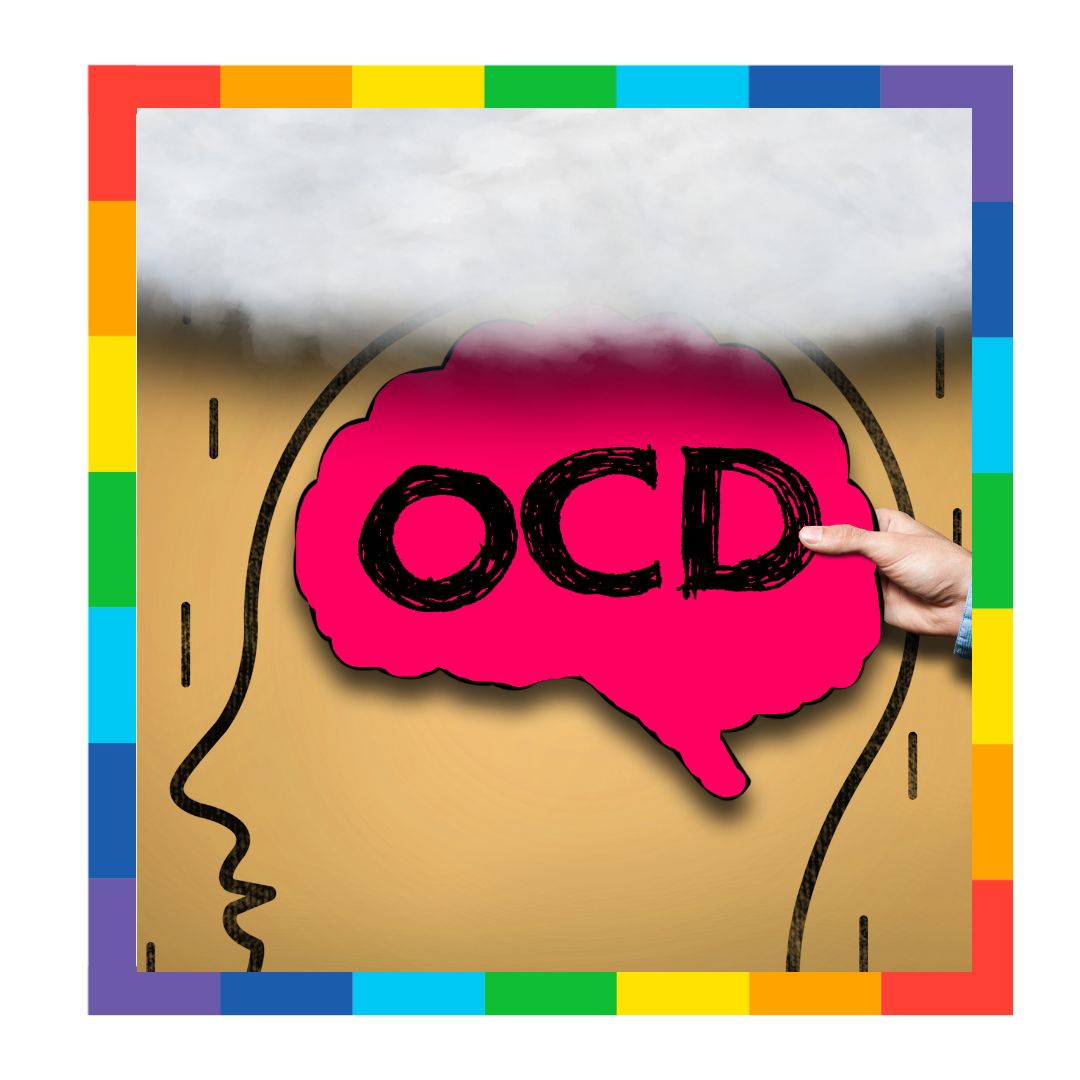
Parenting Tips
Obsessive-Compulsive Disorder in Children – How to Support?
November 1, 2022
Related
Topics

Hey
-

Back to School: How to Prepare for a Smooth First Day?
September 1, 2025
-

How to Build Resilience in Children? – Never Give Up!
August 8, 2025
-

Parents Saying ‘No’ – How to Set Limits Without Guilt?
July 15, 2025
-

-

Green Parenting: How to Make Your Home More Eco-Friendly?
April 24, 2025
Ready for more?
Hey
Sign up for Rainbow Kiddies newsletters for more stories and updates
Obsessive-compulsive disorder (OCD) is an anxiety disorder that can happen in children and adults. It is characterized by obsessions which increase anxiety; and by compulsions which decrease anxiety temporarily. Read on to learn how to support children with OCD.

The obsessive-compulsive disorder cycle
Obsessions are intrusive thoughts (ideas, images, or impulses) that repeatedly enter a person’s mind against their will. These generate anxiety and are difficult to dismiss. Compulsions or rituals are repetitive acts that are performed to reduce this anxiety, but the relief is only temporary. Engaging in these compulsions brings no pleasure. They are excessive and not realistically related to the problem they intend to fix. Later the rituals may become more automatic and increase anxiety. Psychological theories of OCD suggest that ritualizing maintains the problem by preventing habituation to the anxiety and by not letting the child face their fears.
Know More About Obsessive-Compulsive Disorder (OCD):
- Symptoms of OCD
- Severity of OCD
- Causes of OCD
- Risk factors for OCD
- Complications from OCD
- Prevention of OCD
- When to See a Doctor?
- OCD Diagnosis
- OCD Treatment and Support
- OCD-related Conditions
- Information and Self-Help Books for children, Parents and Caregivers
Symptoms of Obsessive-Compulsive Disorder (OCD)
Obsessive-compulsive disorder usually includes both obsessions and compulsions. But it is also possible to have only either of these symptoms. The child may or may not realize that their obsessions and compulsions are excessive or unreasonable, but they take up a great deal of time. They gradually start to interfere with their daily routine and thereby, functioning in social or school settings.
Symptoms or Themes of Obsessions:
- Fear of contamination by bodily fluids, germs, dirt, or other substances. This can lead to repeated cleaning or washing of own body parts, surfaces, or objects. Some children may avoid crowds, handshakes and touching common surfaces for fear of contracting germs. Some feel contaminated when ill-treated or criticized and may try to wash off this feeling.
- Intense focus on exactness or remembering things, orderly and symmetrical arrangements, etc.
- Doubting and having difficulty tolerating uncertainty. Some children doubt whether the bag or school locker is closed or not. They may be concerned with getting a physical illness or disease while there are no symptoms.
- Aggressive thoughts about losing control and harming self or others, being responsible for a catastrophic event, etc. Though the thoughts cause high distress, the child is unlikely to act in a way they fear. Some children might also have thoughts about shouting obscenities or acting inappropriately in public.
- Adolescents might have unwanted sexual thoughts, images, or impulses that involve children, or obsessions about aggressive sexual behavior towards others.
- Religious obsessions could be concerned with offending God, or with right/wrong or morality. Besides, some children might also have superstitions about lucky and unlucky numbers.
Symptoms or Themes of Compulsions:
- Washing and cleaning, including handwashing, brushing teeth, bathing very often and for prolonged hours due to fear of contamination.
- Checking repeatedly for problems with toys, objects and appliances to prevent loss, damage, shock or fire. Besides, some children might check body for signs of illness; spend time confirming the authenticity of memories. Meanwhile there might be others who repeatedly check communication such as e-mails, for fear of having made a mistake or offending the recipient.
- Some children feel that they need to arrange objects in a certain order to avoid discomfort or harm. For example, they may repeatedly rearrange the books on a shelf.
- Counting and repeating routine activities, such as getting up from a chair or touching something a set number of times.
- Mental compulsions, such as repeatedly reviewing an event to ensure that you have not harmed anyone in any way.
- Following strict routine.
- Demanding reassurance from others.
- Hoarding involves a child feeling unable to throw away used or useless possessions.
- Repeating actions with numerous successive occurrences. These are called tics. For instance, a child might reach out and touch something repeatedly or kick out with one leg and then the other. They will be able to suppress the actions for a while. This would further result in growing discomfort until it is relieved by performing the tic. No one knows the cause of tics. Stress and sleep deprivation seem to play a role in the occurrence and severity of motor tics.
Severity of Obsessive-Compulsive Disorder (OCD)
Obsessive-compulsive disorder can occur throughout the life span, and children as young as 6 or 7 often show OCD symptoms. Most adults with the disorder report onset in childhood or adolescence.
Symptoms usually begin gradually and tend to vary in severity and themes throughout life. Besides, symptoms generally worsen with more stress. It can be mild to moderate symptoms or be so severe and time-consuming that it becomes disabling. Eventually some children might drop out of school and adults might become housebound. If left untreated, it generally persists, yet effective treatments are available.
Causes of Obsessive-Compulsive Disorder (OCD)
The causes of OCD are not fully understood. Some of the main theories include:
Autoimmune-related Causes
OCD may be a result of changes in your body’s chemical or brain functions. Sometimes, symptoms of OCD appear in children after an infection, including strep throat, H1N1 flu virus, etc. In such cases, the symptoms start suddenly and reach full intensity within twenty four to seventy two hours. They may then disappear but return later.
Genetics
OCD may have a genetic component, but specific genes have not yet been identified. Further, imaging studies have suggested that the brains of people with OCD function differently. Genes that impact the brain’s response to neurotransmitters like dopamine and serotonin may also play a role in causing OCD.
Behavioral Causes
As per this theory, the initial fear may begin around a period of intense stress, such as a traumatic event or loss. Once the child associates an object or circumstance with this feeling of fear, they begin to avoid that assumed cause. As per research, this might be more common among people with a genetic predisposition for the disorder.
Cognitive Causes
Most children have irrational thoughts at times, but for those with OCD, the importance of these thoughts becomes extreme. As a result, in response, they take excessive, continual action to prevent the threat or danger. For instance, a child under intense pressure might feel that they might harm the person who they believe might be causing it. It might be a parent or teacher. Under normal circumstances they might simply avoid such thoughts. If having OCD, such thoughts become excessive, and they find solace in some ritual to prevent it from happening.
Environmental Causes
Stressful life events may trigger OCD in children with a predisposition to it, genetic or otherwise. Many parents have reported that the symptoms appeared within 6 months of events such as severe conflict, serious illness, or a traumatic brain injury. Besides, OCD might sometimes occur alongside post-traumatic stress disorder (PTSD) also.
Risk factors for Obsessive-Compulsive Disorder (OCD)

Factors that may increase the risk of developing or triggering OCD include:
Family History
Having parents or other family members with the disorder can increase a child’s risk of developing OCD.
Traumatic Experiences
Children who experience physical or emotional abuse have a higher risk. This could also include traumatic childhood experiences, like bullying, severe neglect, or sexual abuse, etc.
Other Mental Health Disorders
OCD may be related to other mental health disorders, such as anxiety disorders, depression, or attention deficit hyperactivity disorder (ADHD).
ADHD is a mental health condition that can cause unusual levels of hyperactivity and impulsive behaviors. The child might have trouble focusing their attention on a single task or sitting still for long periods of time. In addition, they can be forgetful about completing tasks. They might also interrupt people while they are talking.
Tic disorders like Tourette syndrome is another risk factor. It is a syndrome that involves recurrent involuntary tics, which are repeated. These are involuntary physical movements and vocal outbursts.
Other factors could be social anxiety disorder, eating disorders or substance abuse. In fact, majority of the people living with OCD have another mental health condition, with anxiety conditions being the most common. That said, having one of these conditions does not automatically mean that you are more likely to have OCD. Meanwhile read this book with your child if they seem to show signs of social anxiety, or read this article on how to help children with social anxiety.
Personality
Children who have difficulty handling uncertainty and responsibility, or are perfectionists, may have more chances of developing OCD. However, there is some debate over whether these are fixed traits or learned responses that can be changed.
Others
According to a 2021 study, symptoms of OCD could also appear for the first time following a head injury.
Complications from Obsessive-Compulsive Disorder (OCD)
Problems resulting from OCD may include:
- excessive time spent in rituals resulting in disrupted routines
- health issues such as dermatitis from frequent handwashing
- difficulty engaging in play, school, or social activities
- low self-esteem
- imagine having physical illness, sometimes due to stress
- trouble forming or maintaining friendships and other relationships
- overall poor quality of life
- suicidal thoughts and behavior in some cases
Prevention of Obsessive-Compulsive Disorder (OCD)
There is no exact way to prevent OCD. However, getting treatment as soon as possible may help prevent it from worsening and from disrupting normal life. Read on to know more.
When to See a Doctor?
There is a difference between being a perfectionist (someone who requires flawless results or performance) and having OCD. If your obsessions and compulsions are affecting your quality of life, see your doctor or mental health professional.
People of all ages with OCD understand the senseless nature of their obsessions and compulsions. This may lead to shame, reluctance to seek help, and incorrect diagnosis by health professionals. People with the disorder have long delays (17 years on average as per a study) in accessing effective treatments. They are frequently taken to non-psychiatrists for treatment of skin issues or other illness, and the underlying psychiatric symptoms go undetected. Ensure that your child gets help quickly so they will not carry this condition into their adulthood.
Obsessive-Compulsive Disorder (OCD) Diagnosis
Quick screening for OCD includes questions like:
- Do you wash or clean a lot?
- Do you check things a lot?
- Does something constantly bother you? Do you want to get rid of it, but cannot?
- Do you take a long time to finish your daily activities?
- Are you concerned about orderliness or symmetry, repetitions, numbers?
- Do these problems trouble you, and how much?
Your child’s doctor may do a physical examination and blood tests to make sure that their issues are not being caused by something else. They will also discuss their feelings, thoughts, habits, etc.
Doctors look for specific criteria when diagnosing OCD, including:
- the presence of obsessions, compulsions, or both, that are time-consuming or cause significant distress or disrupt social, or other settings.
- OCD symptoms that do not result from the use of a substance or medication.
- OCD symptoms that cannot be better explained by another health issue.
Once the diagnosis has been made, the use of standardized instruments may help to define the profile and severity of OCD. These instruments might also be used to monitor response to treatment.
Treatment and Support for Obsessive-Compulsive Disorder (OCD)
There is no complete cure for OCD, but you may be able to manage how the symptoms affect your child’s life through medicine, therapy, or a combination of treatments. There are several therapies and medical procedures that therapists, psychologists, or psychiatrists might use to help children who have OCD. I am mentioning only the ones which parents and caretakers can use to support such children at home in addition to professional support.
Behavioral therapy
It involves exposure and response prevention (ERP) and cognitive behavioral therapy (CBT). The child is exposed to situations and objects that trigger fear or anxiety in them. Repeated exposure leads to a decrease in anxiety over time, this is called habituation. Family or caregivers can be enlisted to help with exposure practice at home. Response teaches the child to resist compulsive behaviors. CBT starts by encouraging the child to identify and revaluate their beliefs about the consequences of indulging or not indulging in compulsive behavior. The therapist may help develop a less threatening alternate response to the obsession.
Relaxation and Self-Care
Therapists can also offer guidance with coping strategies. These could be breathing exercises, yoga, meditation, or other mindfulness techniques. It could also include creating a self-care routine, talking to loved ones, etc.
Though it might feel difficult to talk about OCD with loved ones, isolating oneself only makes matters worse. Reaching out to family, friends, and loved ones can make it easier for the child to get emotional or any other kind of support.
Family members should be educated regarding helpful ways to support the child. These include cutting down on expressing negative emotions, refraining from giving reassurance to the child, etc.
Joining an OCD support group can be another great way to connect with other children who understand what they are experiencing.
Some children with OCD fail to respond adequately to either cognitive behavior therapy, drugs, or a combination of the two. For such cases, careful reassessment to detect and treat related problems may improve outcomes. For example, children with developmental difficulties on the autism spectrum may be susceptible to OCD as teenagers. These patients might need specially tailored cognitive behavior therapy.
OCD-related Conditions
Some separate conditions that are similar or related to OCD:
- Some children might be upset about their physical appearance and have fixated thoughts about it.
- Another condition involves persistent urges to pull out hair from any part of one’s own body (eyebrow, scalp, eyelashes, etc.). The hair-pulling behaviors are often in response to stress from school, family, or social aspects of life. The common obvious impact is having patchy bald spots and significant hair loss. This could lead to further distress due to changes in physical appearance.
- Depression can involve looping unwanted thoughts, but these thoughts generally do not lead to compulsive behaviors.
- Hoarding disorder involves collecting an excess of used or unwanted objects and having difficulty throwing them away. These possessions do not trigger distress. Children with this OCD might feel a compulsion to complete a set, or because they believe that not keeping those items might lead to some harm.
- Generalized anxiety disorder also involves frequent and persistent worries. These concerns often relate to everyday life. While they might lead the child to avoid certain people or situations, they generally do not lead to compulsive actions.
- Tics, or sudden, repeated movements, can happen with OCD. It is not uncommon for people with OCD to also have a tic disorder. But you can also have a tic disorder without having OCD.
- Chronic skin-picking is repeated picking at one’s own skin which results in skin lesions. This can also disrupt life.
- Health anxiety is worrying excessively that you are or may fall seriously ill. You may have no physical symptoms though.
- Some children believe that they have an unpleasant body odor. This results in high distress and is often accompanied by repetitive behavior such as frequent showering.
Information and Self-Help Books for children, Parents and Caregivers
Self-help Books
Wagner A. Up and down the worry hill. New York: Lighthouse Press, 2002. An illustrated book to help parents and professionals explain OCD to younger children.
Wever C, Phillips N. The secret problem. Sydney: Shrink-Rap Press, 1996. A cartoon book that describes OCD and its treatments in simple language to help children, teenagers, and parents.
Hyman B, Pedrick C. The OCD workbook: your guide to breaking free from obsessive-compulsive disorder. Oakland, CA: New Harbinger Publications, 2005. A self-help manual for adults/ youth, guides through ERP and has advice for family.
Veale D, Willson R. Overcoming obsessive compulsive disorder. London: Constable & Robinson, 2005. A self-help book suitable for adults and youth.
Schwartz JM. Brain lock: free yourself from obsessive compulsive behavior. New York: Harper Collins, 1997. A self-treatment manual suitable for adults and youth.
Self-Help Websites and Apps
South London and Maudsley NHS Trust
Want Rainbow Kiddies' updates sent straight to your inbox? And also get a surprise welcome gift!




